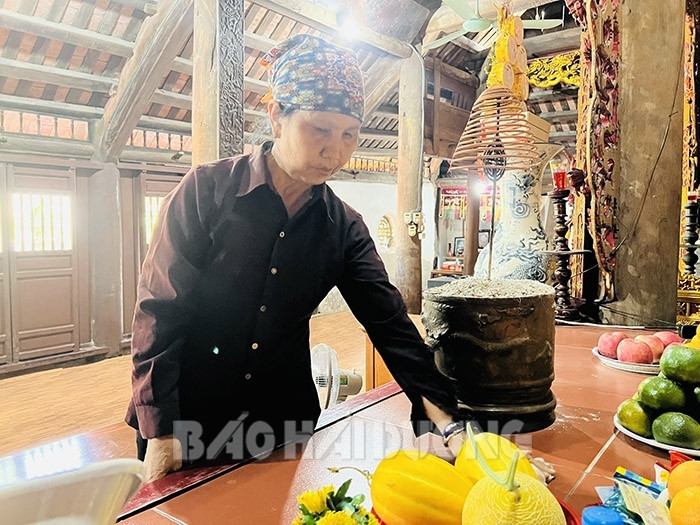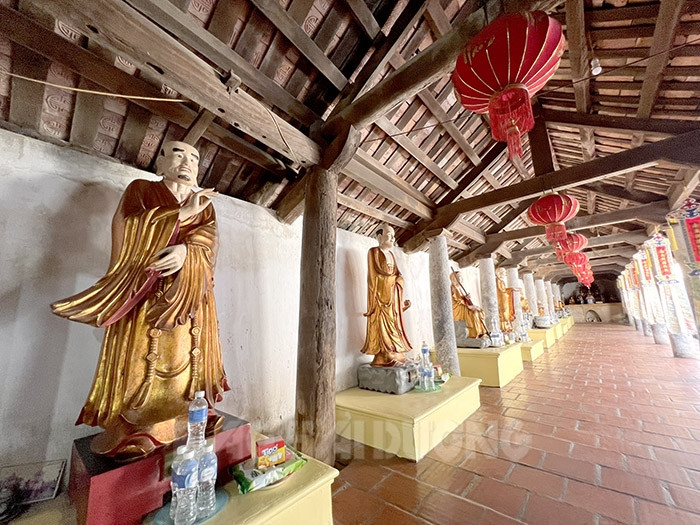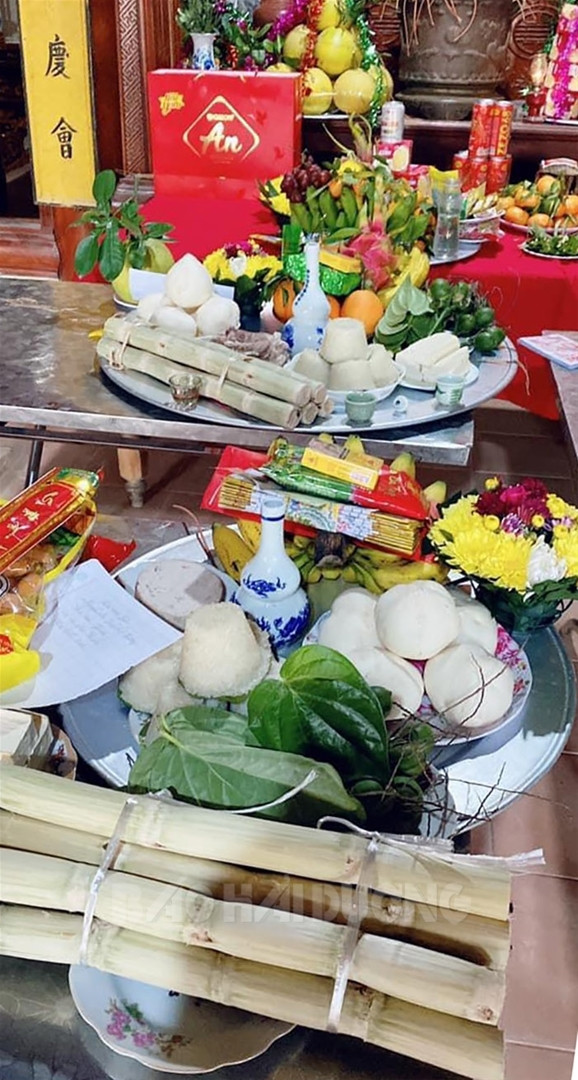As one of the few communes with 3 national historical relics, the government and people of Tan Ky (Tu Ky) are always proud and unanimous in protecting these relics.

The altars at Nghi Khe Pagoda are regularly maintained.
Unique
Tan Ky commune has 3 national historical relics: Quynh Goi and Ngoc Lam communal houses (Ngoc Lam village), Nghi Khe pagoda (Nghi Khe village).
Ngoc Lam and Quynh Goi communal houses both worship Cao Son Dai Vuong, who helped King Hung Due Vuong defeat the Thuc invaders and bring peace to the country. However, each communal house has its own unique features.
According to legend, while leading troops to fight the enemy, Cao Son went to Ngoc Lam camp, Tu Ky district, Ha Hong prefecture, Hai Duong province to set up a fort. The people and elders of Ngoc Lam camp performed a ceremony, and Cao Son agreed and selected 10 young men to join the army. After Cao Son died, the king was extremely sorry, gave a lot of gold and silver to hold a ceremony, and at the same time issued an edict to the mandarins, districts, prefectures, wards, and camps where Cao Son's children were his subjects to build temples to worship.
At Ngoc Lam camp, the people built 3 communal houses to worship Cao Vuong, appointed Cao Son as the village's God, and built 3 communal houses to worship him: Quynh Goi, Ngoc Lam and Thuong Lang. According to village custom, the Quynh Goi communal house festival is held on February 8 (lunar calendar), commemorating the birthday of the village's God; Ngoc Lam communal house holds a festival on November 12, the day of his death; Thuong Lang communal house holds a festival on March 8, the day of victory (the relic no longer exists, so the festival is not held).

Many antiques are kept at Ngoc Lam communal house.
At Quynh Goi communal house, the festival is held on the birthday so it is joyful and bustling, with Cheo singing, water puppetry, wrestling, human chess... The procession of the royal edict and the idol all wear red-collared shirts with yellow borders, and have cheerful faces. At Ngoc Lam communal house, because the festival is held on the death day, there is a look of sadness and respect. The procession is quiet, the people wearing white pants, dark shirts, red belts and black hats, the offerings only have vegetarian offerings, no meat offerings.
Nghi Khe Pagoda is a place to worship Mahayana Buddhism, worshiping the village's god Nguyen Phuc Ho, a general of the pre-Le dynasty who fought against the Siamese and eliminated the Song invaders.
Nghi Khe Pagoda has an artistic architecture that is rarely found anywhere else. It still preserves many features of the Le Dynasty's sculpture art with an internal and external architecture. In the pagoda, there are many large, symmetrically arranged large inscriptions with profound meanings. The two gable rooms are connected to two corridors, creating a closed space. The rear palace consists of 3 rooms connected to the central room, where the Buddha statues and the temple's sacrificial objects are displayed. On the left corridor, there is an altar for the Mother Goddess, on the right, there is an altar for the Goddess of Mercy. The ancestral house consists of 7 rooms at the back of the pagoda...

The system of Buddha statues, a unique feature in Nghi Khe pagoda
Maintain
Aware of the great cultural and historical value of the relics, in recent times, Tan Ky commune and local people have taken many measures to preserve the architecture, landscape as well as spiritual values.
Ms. Do Thi Thu Huong, a cultural officer of the commune, said that these relics have all been inventoried and cabinets have been installed or assigned to individuals for preservation, protection, and to prevent termites and theft. The relics all have surveillance cameras inside and outside, and are equipped with fire extinguishers. Every month, the Commune People's Committee organizes inspections on the preservation and maintenance of relics, the organization of activities at communal houses and pagodas, the current status of the works... to have appropriate management measures.
While many places only perform rituals during festivals, Tan Ky is different. On the first and fifteenth day of the lunar month, members of the Ritual Committee wear festive clothes and costumes to perform rituals and prayers appropriate to each day.

The offering tray of the family with the newborn son at Ngoc Lam communal house. Photo: Do Thi Thu Huong, cultural officer of Tan Ky commune
Each person in Tan Ky commune has made different contributions to preserving and promoting the value of the relics. Mr. Nguyen Huy Man (in Ngoc Lam village) said that when Ngoc Lam communal house was degraded, with the consent of departments and branches, the people agreed to renovate the communal house. At that time, the budget was only over 100 million VND, while it was expected to need about 800 million VND. Participating in the Propaganda Committee, he wrote 5 articles to broadcast on the commune's radio system, and at the same time went to families of Ngoc Lam's children living in some neighboring provinces and cities or called to mobilize contributions. "In just a short time, we mobilized more than 1.3 billion VND (including artifacts converted into money) and many working days to renovate the communal house. There were families who contributed tens of millions of VND. Thanks to that, the project was renovated," said Mr. Man.
In Tan Ky, many beautiful cultural and spiritual traditions are still preserved and developed. Ms. Nguyen Thi Nga (in Ngoc Lam village) said that after she gave birth to her son, on the occasion of the most recent festival, she and her husband's family prepared offerings and went to the communal house to burn incense. "According to the village's custom, any family that gives birth to a son must bring him to the communal house to perform the ceremony in order to be recognized as a descendant of the village. Each family prepares different offerings, but all must have sugarcane peeled clean, neatly bundled, jicama, sticky rice...", Ms. Nga said.
With the participation of the government and the consensus of the people, the cultural beauty and architectural beauty of ancient works will certainly not be lost but will be forever preserved and further promoted.
THANH HA